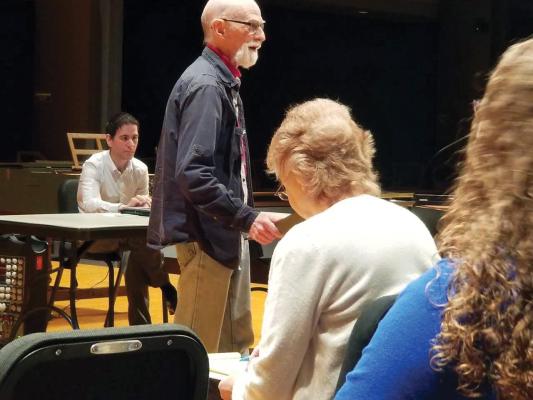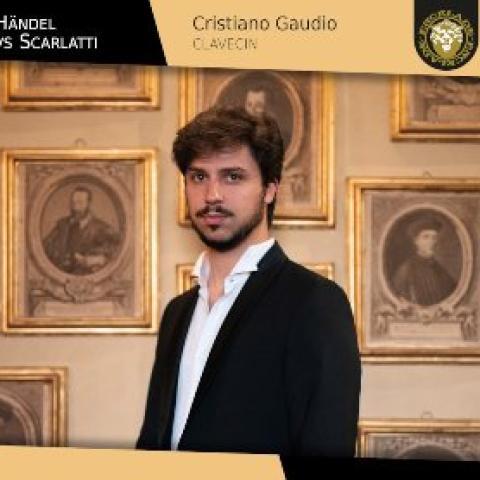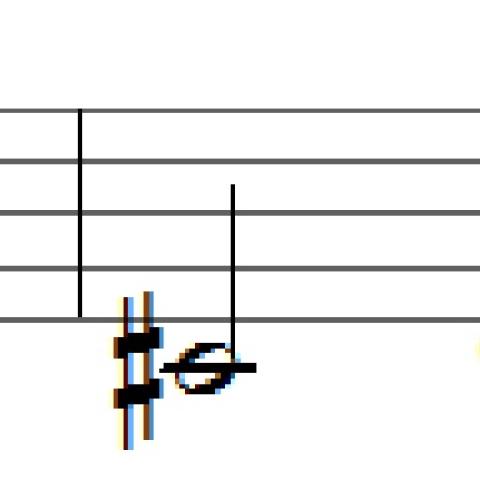
Scarlatti’s cat in London, Vienna, and Texas
Our story begins with Thomas Roseingrave, born in Winchester, England, in 1688. He emigrated to Dublin, Ireland, with his father, his first music teacher. In 1707 he entered Trinity College, but did not complete his degree. A life-changing trip to Italy was financed in 1709 by Saint Patrick’s Cathedral, “to improve himself in the art of music that hereafter he may be serviceable to the Cathedral’s music program.”
It was at the home of a nobleman in Venice that young Roseingrave was invited to play the harpsichord. As he related to music historian Charles Burney some years later, “finding myself rather better in courage and finger than usual, I exerted myself and fancied by the applause I received that my performance had made some impression on the audience . . . .” Burney continues,
". . . a grave young man dressed in black and in a black wig had stood in one corner of the room, very quiet and attentive while Roseingrave played. Being asked to sit down at the harpsichord, when he began to play, ‘Rosy’ said he thought ten hundred devils had been at the instrument. He never had heard such passages of execution and effect before. Inquiring the name of this extraordinary performer he was told it was Domenico Scarlatti, son of the famous opera composer Alessandro Scarlatti. Roseingrave did not touch the harpsichord for a month following this experience, but, after his hiatus he became very intimate with the young Scarlatti, following him to Rome and Naples, and hardly ever leaving him during his time in Italy . . . ."
Returning to England in 1714 or 1715, Roseingrave continued to champion Scarlatti’s music, producing one of his operas at the Haymarket Theatre and publishing an edition of forty-two Scarlatti sonatas in 1739, a volume that included some examples from the 1728 Essercizi, including Kirkpatrick number 30, the “Cat’s Fugue,” which came to bear the descriptive title that is often credited to the composer Muzio Filippo Vincenzo Francesco Saverio Clementi, born in 1770 in Bonn. And why, you may ask, is it universally known today as something to do with a cat?
That answer derives from its wide-ranging fugal subject that begins on the G below middle C and continues upward dotted quarter note by dotted quarter with these intervals: G–B-flat, E-flat–F-sharp, B-flat–C-sharp, then cascades downward in eighth notes: D, C-natural, B-flat, A, G, F-sharp, G—a rather strange subject, but, bearing Scarlatti’s original tempo indication of “Moderato” this 6/8 theme does indeed sound rather like a middle-aged tabby cat walking on its favorite harpsichord keys!
I would emphasize the moderate tempo should you wish to play this audience-pleasing harpsichord or organ sonata! A Lyrachord recording by a very fine harpsichordist who is excessively fleet of finger rather destroys the fun and enjoyment of the quite unusual harmonies generated. Of course, I, too, have been guilty of playing too quickly many times, but once I approached retirement age I found that I really preferred to dwell longer on sonorities that I find beautiful. (Although my late-in-career students would probably counter, “But he always mentioned that he would prefer a slightly slower tempo!”)
Roseingrave made a number of changes to Scarlatti’s score of K. 30: these included a few differing notes, some octave doublings, and the replacing of many dotted quarter notes with a plain quarter, followed by an eighth rest rather than a dot—making these passages much more suitable to the organ and to the resonant acoustics of London churches. Speaking of which it may be of interest that Roseingrave, in 1725, became the organist of Saint George’s, Hanover Square, the parish church of none other than George Frederic Handel, the longest-lived of the 1685 triumvirate.1
If one should wish to play from Roseingrave’s score, the best edition of K. 30 is a 1972 publication from Alfred Music, New York, edited by Willard Palmer (who used to say when I was performing in his presence, “Unfortunately, no relation”) and Margery Halford, both Houston-based early-music supporters. These intrepid researchers compared all the earliest printings (there is no autograph known to exist)—and their edition contains a facsimile of the work from the first printed edition (London, 1738) of which the first copy was presented by the composer to his patron King Joâo V of Portugal. Roseingrave’s changes to the score are given in smaller staves directly above the affected measures, and other divergences are indicated by footnotes referencing a copy of Scarlatti’s first edition that was reprinted by Witvogel in 1742 and Clementi’s version, published about 1811 in the second of four volumes comprising Clementi’s Selection of Practical Harmony. All of these useful addenda resulted in a score of 10 pages: the most comprehensive edition that I have found of this iconic work.
To continue with the references found in my title, I used an April 2019 recording from a demonstration concert performed on the oldest playable organ in Texas, the Caetano Oldovini organ built in 1762 and now housed in Southern Methodist University’s Meadows Art Museum. This instrument was originally in the Monks’ Gallery of Evora Cathedral in the university city of that name in Portugal, where it was one of three organs in the building.
Vienna: Reicha
A composition that I have never encountered on anyone else’s concert programs is the Fugue on a Theme by Domenico Scarlatti, opus 36/9 by Antoine Reicha. I found this delightful homage in Volume 2 of Bohemian Piano Music from the Classical Period, edited by Peter Roggenkamp, published by Universal Edition, Vienna (UE18583), in 1990. Perhaps Reicha, an exact contemporary of Beethoven (both born in 1770) felt some special kinship when he moved from Prague to Bonn with his parents in 1785?
In 1799 Reicha traveled to Vienna with the hope of provoking interest in his newly composed opera. His first visit was not to Beethoven, however, but to his idol, Josef Haydn, to whom his opus 36, a collection of contrapuntal works, is dedicated.
Eventually Reicha moved to Paris, where in 1818 he was appointed professor of counterpoint and fugue at the Paris Conservatoire, where his classes included such now well-known figures as Hector Berlioz, Franz Liszt, and, for the ten months prior to his death in 1836, as special mentor to César Franck!
Reicha’s “Cat Fugato” (pun intended) with its tempo indication of “Allegro moderato” may portray a slightly younger cat than Scarlatti’s, but the theme is the same, and the full title Fugue on a Theme from Domenico Scarlatti leaves no doubt as to the homage work that it is. Gently swirling sixteenth notes sound lovely on the harpsichord, and I enjoy, immensely, introducing this beautiful novelty to audiences. Depending on my mood of the moment I sometimes make the piece even more special by changing the concluding chord from minor to major; thus far, no thunderbolt has reached me from the heavens (nor from below the earth), so I suspect that I have the composer’s blessing.
Thus we have fulfilled the offerings named in the title of my presentation for the May conference of the Historical Keyboard Society of North America (HKSNA) held this year at Huntsville, Texas, in the beautiful venues provided by Sam Houston State University. I made an ad hoc quick recording of Reicha’s Fugue utilizing my Richard Kingston Franco-Flemish double harpsichord, to complement the organ solo of Scarlatti’s original Fugue. A neighbor did the recording, and, with the multiple duties of preparing for the trip, I did not check the disc that was offered. Thus, when I checked its suitability and compatibility with my computer, I had the shock of its not being playable.
My rescuer in this debacle was newly minted DMA Silvanio Reis, a star pupil of Temple University’s Joyce Lindorff (who, incidentally, succeeded me as president of the Southeastern Historic Keyboard Society, one of the now-merged components of the current national organization). His computer was receptive to MP-3 recording, and he not only operated the sound for this second selection, but also took over the earlier disc of the organ fugue, which made my morning presentation much easier than I could have imagined. Dr. Reis also made his own presentation, “The International Idiom in the Keyboard Sonatas of Domenico Scarlatti,” during which he played examples from six sonatas as apt musical preludes to my more verbal and humorous offering.
Note
1. Dates given in Gerald Gifford’s article for Grove’s Dictionary of Music, Fifth Edition.
Editor’s note: the staff of THE DIAPASON congratulates Dr. Palmer on being named a member of the International Advisory Panel for the Historical Keyboard Society of North America.




